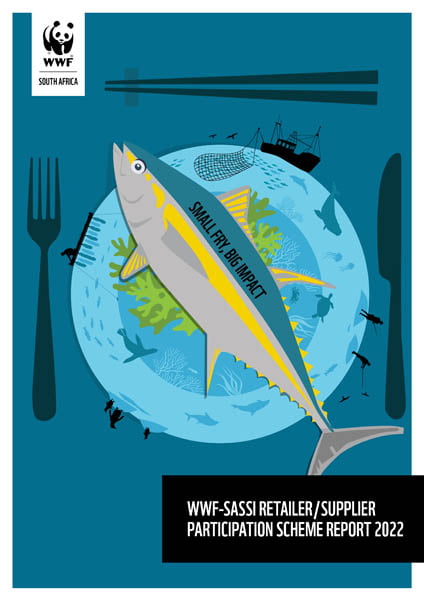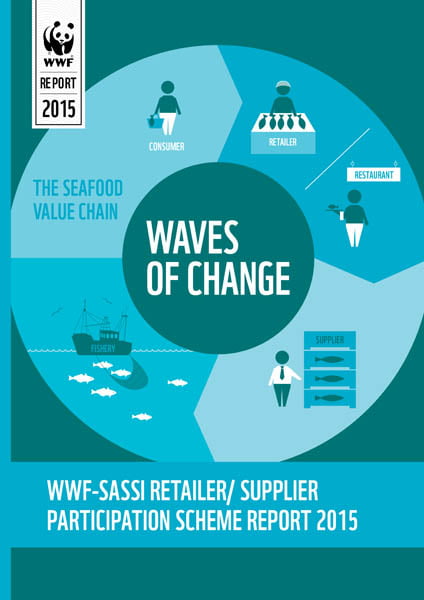Menu
Welcome to our Resource Toolkit, your one-stop destination for information and tools that empower you to join the mission to protect our oceans.
Here you will find apps, games, tools, fascinating facts and a glossary that make it fun and easy to make sustainable seafood choices.

Find out in real time whether to tuck in, think twice or avoid all together!
Get the WWF-SASSI mobile app to easily identify and choose sustainable seafood – while cooking, dining out or shopping! This app provides information on seafood species, their sustainability status, and recommendations for more responsible choices.
We encourage you to always ask the three questions about the fish species, the fishing or farming method used to catch/farm it and its origins. These three pieces of information are key to determining which list the fish appears on. Some fish may appear on more than one list, depending on the answers to these questions.
Our apps are free on Android and iOS!

The compact WWF-SASSI Pocket Card is a handy, wallet-sized reference guide designed to assist you in making the best seafood choices while dining out or shopping.
Our Sustainable Seafood Poster is an eye-catching A0 visual aid with beautiful images of fish on the WWF-SASSI green, orange and red lists, that can be displayed in your kitchen, school, office, education or community center.
Engage in fun and informative games that teach you about the importance of sustainable seafood practices, making learning about marine conservation an enjoyable experience.
Take the helm as a submarine commander exploring South Africa’s oceans and marine wildlife, avoiding ocean hazards and helping to ‘tag fish’ to keep an eye on our oceans. Supported by Vodacom and AVI Community Trust.
Learn through play about sustainable seafood and our oceans with the WWF-SASSI card game. This downloadable book offers more than 15 games and activities for kids and is aligned with the school curriculum (Grades 4 to 10). Cut out and laminate the brightly coloured fish cards for use in the classroom or at home. Let’s play!













Discover intriguing facts, surprising insights, and eye-opening statistics about the world of sustainable seafood, to ensure you’re up to date with reliable information.
Navigating the world of sustainable seafood can sometimes feel like diving into uncharted waters, with all the various labels, certifications, and terms.
It’s essential to have a reliable resource that clarifies the meanings behind the terminology and our Sustainable Seafood Glossary demystifies the language of sustainability, empowering you to make eco-conscious seafood choices.
The obligation of an individual or organisation to account for its activities, accept responsibility for them, and to disclose the results in a transparent manner.
The cultivation of aquatic animals and plants, especially fish, shellfish, and seaweed, in natural or controlled marine or freshwater environments. Also known as farmed fish and can be farmed in a variety of ways e.g. ropes, cages, ponds, etc.
the Aquaculture Stewardship Council (ASC) is an independent, international non-profit organisation that manages the world’s leading certification and labelling programme for responsible aquaculture.
Seafood on the red list that are either no sale recreational or specially protected species. No sale recreational species may be caught by recreational fishers but are not permitted to be sold. Specially protected species are not to be caught by any fishers (both commercial, recreational and small scale).
Any catch of species (fish, sharks, marine mammals, sea turtles, seabirds, etc.) other than the target species. “Incidental catch” can be regarded as synonymous. Bycatch may be either retained (that portion sometimes called “byproduct”) or discarded.
Corporate social responsibility (CSR) is a business approach that contributes to sustainable development by delivering economic, social and environmental benefits for all stakeholders. CSR is a concept with many definitions and practices.
These are the most sustainable seafood choices from the healthiest and most well-managed populations. These species can handle current fishing pressure or are fished or farmed in a way that does not harm the ocean.
Maximum sustainable yield (MSY) is having abundance at or close to the level of Maximum Sustainable Yield (MSY). MSY is the level at which the fish are able to reproduce and replenish at the same rate that they are being fished out.
The Marine Stewardship Council (MSC) is an independent third party certification scheme that assesses the environmental sustainability and management of wild-caught fisheries.
A species that has been fished to a point where the fish species cannot replace itself through natural reproduction. In this state, it is considered depleted.
Overfishing occurs when more fish are caught than the population can replace through natural reproduction.
Seafood from unsustainable populations, that have extreme environmental concerns, lack appropriate management or are ‘no sale species’, illegal to buy or sell in South Africa.
ROI is usually expressed as a percentage and is typically used for financial decisions, to compare a company’s profitability or to compare the efficiency of different investments. The return on investment formula is: ROI = (Net Profit / Cost of Investment) x 100.
A set of consumer-focused tools including the WWF-SASSI Apps, FishMS, poster and pocket card, to help you make sustainable decisions.
Those species (often it is the species that is permitted to be caught) primarily sought by the fishermen in a particular fishery i.e. the subject of directed fishing efforts in a fishery. There may be primary as well as secondary target species.
Traceability is the ability to track a product from boat to plate. In supply chain traceability, it is the ability to identify, track and trace elements of a product or substance as it moves along the supply chain from raw goods to finished products. Sub-industries in each category and in different geographic areas may define the concept to fit their own needs, but at its simplest traceability enables a breadth and depth of visibility into what goes into produced goods and substances.
Quick links
© WWF SASSI | WordPress website design and development by The Ethical Agency, a leading Digital Marketing Agency for sustainable brands | Website powered by green renewable energy website hosting.